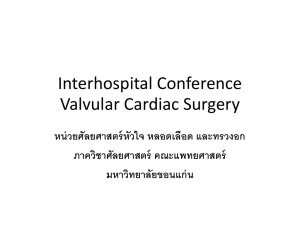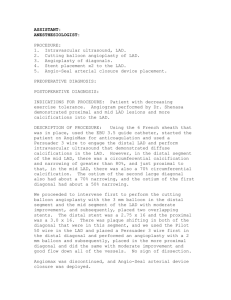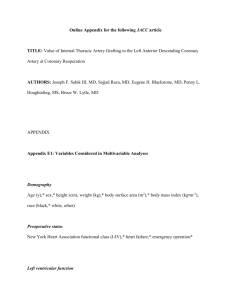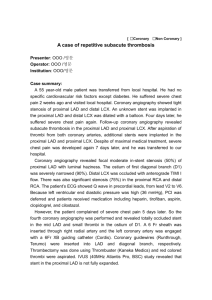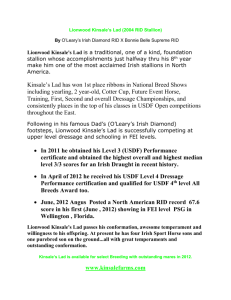References - JACC: Cardiovascular Imaging
advertisement
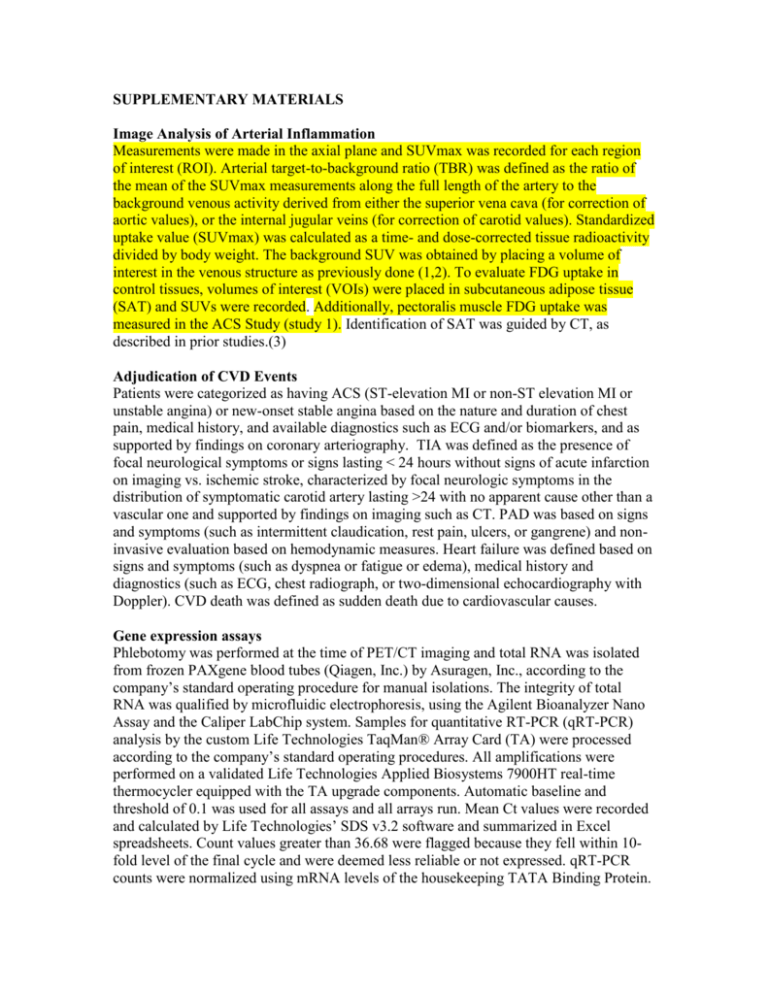
SUPPLEMENTARY MATERIALS Image Analysis of Arterial Inflammation Measurements were made in the axial plane and SUVmax was recorded for each region of interest (ROI). Arterial target-to-background ratio (TBR) was defined as the ratio of the mean of the SUVmax measurements along the full length of the artery to the background venous activity derived from either the superior vena cava (for correction of aortic values), or the internal jugular veins (for correction of carotid values). Standardized uptake value (SUVmax) was calculated as a time- and dose-corrected tissue radioactivity divided by body weight. The background SUV was obtained by placing a volume of interest in the venous structure as previously done (1,2). To evaluate FDG uptake in control tissues, volumes of interest (VOIs) were placed in subcutaneous adipose tissue (SAT) and SUVs were recorded. Additionally, pectoralis muscle FDG uptake was measured in the ACS Study (study 1). Identification of SAT was guided by CT, as described in prior studies.(3) Adjudication of CVD Events Patients were categorized as having ACS (ST-elevation MI or non-ST elevation MI or unstable angina) or new-onset stable angina based on the nature and duration of chest pain, medical history, and available diagnostics such as ECG and/or biomarkers, and as supported by findings on coronary arteriography. TIA was defined as the presence of focal neurological symptoms or signs lasting < 24 hours without signs of acute infarction on imaging vs. ischemic stroke, characterized by focal neurologic symptoms in the distribution of symptomatic carotid artery lasting >24 with no apparent cause other than a vascular one and supported by findings on imaging such as CT. PAD was based on signs and symptoms (such as intermittent claudication, rest pain, ulcers, or gangrene) and noninvasive evaluation based on hemodynamic measures. Heart failure was defined based on signs and symptoms (such as dyspnea or fatigue or edema), medical history and diagnostics (such as ECG, chest radiograph, or two-dimensional echocardiography with Doppler). CVD death was defined as sudden death due to cardiovascular causes. Gene expression assays Phlebotomy was performed at the time of PET/CT imaging and total RNA was isolated from frozen PAXgene blood tubes (Qiagen, Inc.) by Asuragen, Inc., according to the company’s standard operating procedure for manual isolations. The integrity of total RNA was qualified by microfluidic electrophoresis, using the Agilent Bioanalyzer Nano Assay and the Caliper LabChip system. Samples for quantitative RT-PCR (qRT-PCR) analysis by the custom Life Technologies TaqMan® Array Card (TA) were processed according to the company’s standard operating procedures. All amplifications were performed on a validated Life Technologies Applied Biosystems 7900HT real-time thermocycler equipped with the TA upgrade components. Automatic baseline and threshold of 0.1 was used for all assays and all arrays run. Mean Ct values were recorded and calculated by Life Technologies’ SDS v3.2 software and summarized in Excel spreadsheets. Count values greater than 36.68 were flagged because they fell within 10fold level of the final cycle and were deemed less reliable or not expressed. qRT-PCR counts were normalized using mRNA levels of the housekeeping TATA Binding Protein. Supplemental Figure 1: Measurement of Splenic Metabolic Activity Splenic FDG uptake was assessed by manually drawing a region of interest (ROI) (shown as the red circle) in axial (A), sagittal (B) and coronal (C) planes. SUVmax was recorded in each ROI, and average splenic activity was calculated as mean of SUVmax values of the 3 ROIs. Abbreviations: FDG, 18F-flurodeoxyglucose; SUV, Standardized Uptake Value; TBR, target-to-background ratio. Supplemental Figure 1. Supplemental Table 1. Summary of ACS Patient Presentations Age Gender (yrs) ACS Classification 38 F UAP 60 M NSTEMI 43 M UAP 51 F NSTEMI 65 M NSTEMI 53 M UAP 59 F NSTEMI 62 M NSTEMI 69 M NSTEMI 63 M UAP 56 F STEMI 57 F UAP 61 M UAP 66 M UAP 63 F UAP Clinical Presentation Accelerating, severe, exertional typical CP radiating to left arm, alleviated by rest. Accelerating, typical SSCP relieved with rest and nitroglycerin Intermittent, progressive CP associated with SOB, diaphoresis and left arm tingling Progressive, exertional CP and SOB, relieved by rest New-onset, squeezing SSCP radiating to left arm, exertional, and relieved Progressive, exertional CP with minimal exertion, relieved by rest Acute SSCP/tightness radiating to bilateral arms, alleviated with rest Acute-onset, severe SSCP with minimal exertion, relieved by rest Sudden-onset, left arm numbness and CP associated with diaphoresis Progressive, exertional typical CP radiating to throat over 4 days Acute-onset, typical SSCP at rest Accelerating, exertional CP associated with dyspnea, and relieved by rest Progressive, left-sided CP associated with dyspnea, and relieved by rest Acute-onset, exertional jaw pain radiating to throat and shoulders, alleviated with rest Accelerating, exertional CP over 3 weeks associated with nausea, relieved by rest. EKG Changes Troponin Coronary Anatomy Stent Negative 90% prox RCA Yes 0.41 95% RCA Yes Negative 90% PDA, 60% D2 Yes 0.23 90% mid LAD Yes 0.38 80% RCA Yes Normal Negative 99% prox RCA Yes T-wave inversions 6.14 70% prox LAD, 60% LAD Yes Normal 0.62 95% prox LAD Yes STdepressions 3.4 80% D1, 50% LAD Yes Normal Negative 85% LAD, 40% RCA Yes ST-elevation >8 100% mid LCx, 80% RCA Yes T-wave inversions Negative 95% RCA, 70% LCx, Yes Normal Negative 80% ostial LAD, 60% LAD Yes Negative 90% RCA, 60% LCx Yes Negative 85% LAD, 45% LCx Yes T-wave inversions T-wave inversions Normal T-wave inversions STdepressions T-wave inversions T-wave inversions 69 M NSTEMI 64 M UAP 54 M STEMI 67 M NSTEMI 61 M NSTEMI 56 M NSTEMI 45 M STEMI Acute-onset, severe CP radiating to shoulder and jaw Acute-onset, SSCP at rest radiating to left arm and neck associated with face numbness and tingling Sudden-onset, SSCP associated with nausea and left arm numbness Progressive SSCP associated with SOB, neck pain, and left arm tingling Acute CP radiating to both arms, relieved with rest Intermittent exertional chest pressure over 2 weeks associated with dyspnea Acute typical CP awakened from sleep, worse with exertion and relieved by rest ST-depression 27 90% LAD Yes T-wave inversions Negative 90% LAD, 70% LCx Yes ST-elevation Negative 100% prox LAD, 40% RCA Yes ST-depression 0.2 90% LCx, 40% LM Yes ST-depression 0.64 85% RCA Yes T-wave inversion 0.26 90% OM1 Yes ST-elevation Negative 100% prox LAD Yes Abbreviations: CP, chest pain; D, diagonal; ECG, electrocardiogram; LAD, left anterior descending artery, LCx, left circumflex artery; LM, left main; mid, middle; NSTEMI, non-ST elevation myocardial infarction, OM, obtuse marginal; PDA, posterior descending artery; prox, proximal; RCA, right coronary artery; SSCP, substernal chest pain; STEMI, ST elevation myocardial infarction, UAP, unstable angina pectoris 5 Supplemental Table 2. Baseline cancer and cancer treatment status of “Clinical Outcomes” subjects Full Cohort (n=464) Individuals Without Subsequent CVD (n=430) Individuals With Subsequent CVD (n=34) p-value Prior history of cancer None Lymphoma Hemotologic Lung Gastrointestinal Breast Head and Neck Skin Multiple Other 68 (15) 184 (40) 1 (<1) 15 (3) 43 (9) 71 (15) 36 (8) 20 (4) 22 (5) 4 (<1) 57 (13) 177 (41) 1 (<1) 11 (3) 39 (9) 69 (16) 35 (8) 18 (4) 19 (4) 4 (<1) 11 (32) 7 (21) 0 (0) 4 (12) 4 (12) 2 (6) 1 (3) 2 (6) 3 (9) 0 (0) 0.005 0.01 0.92 0.02 0.38 0.08 0.23 0.44 0.23 0.74 None Chemotherapy Radiotherapy Chemoradiotherapy 103 (22) 127 (27) 32 (7) 197 (42) 87 (20) 124 (29) 31 (7) 183 (42) 16 (47) 3 (9) 1 (3) 14 (41) 0.001 0.006 0.29 0.51 Radiation To Chest Immunotherapy (IL2, interferon, G-CSF) 84 (18) 76 (17) 8 (23) 0.26 5 (1) 5 (1) 0 (0) 0.68 Values are presented as n (%). Abbreviations: IL-2, interleukin 2; G-CSF, granulocyte colony stimulating factor 6 References 1. 2. 3. Tawakol A, Fayad ZA, Mogg R, et al. Intensification of statin therapy results in a rapid reduction in atherosclerotic inflammation: results of a multicenter fluorodeoxyglucose-positron emission tomography/computed tomography feasibility study. J Am Coll Cardiol 2013;62:909-17. Subramanian S, Tawakol A, Burdo TH, et al. Arterial inflammation in patients with HIV. JAMA 2012;308:379-86. Rosenquist KJ, Pedley A, Massaro JM, et al. Visceral and subcutaneous fat quality and cardiometabolic risk. JACC Cardiovasc Imaging 2013;6:762-71.
